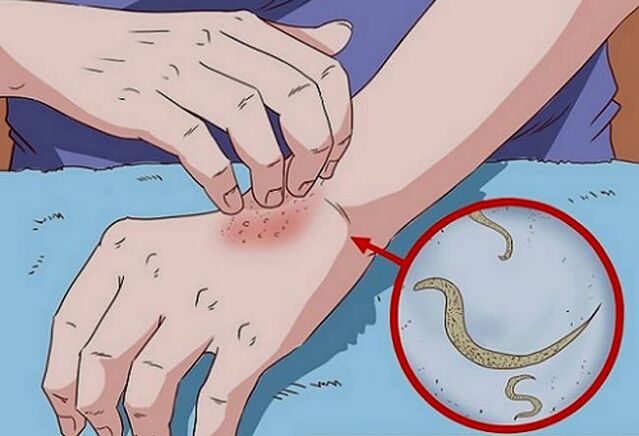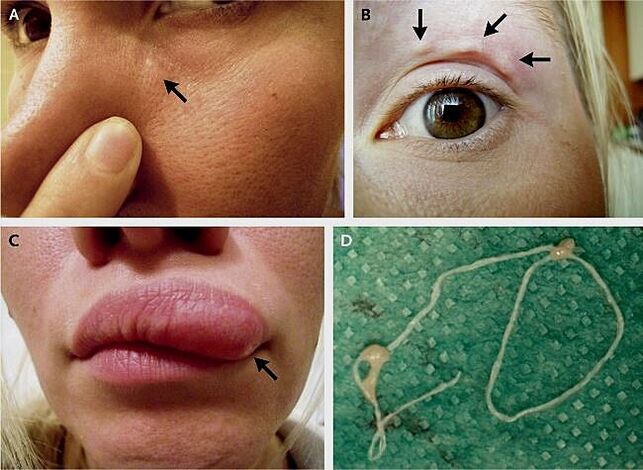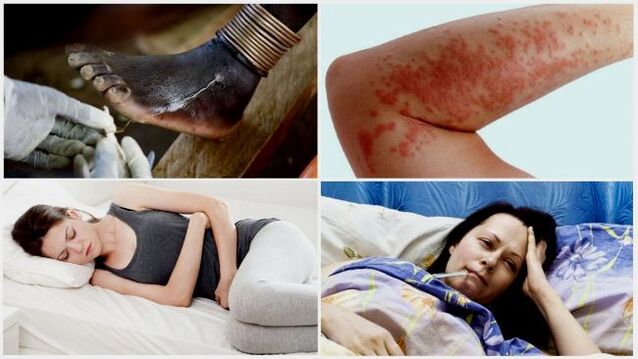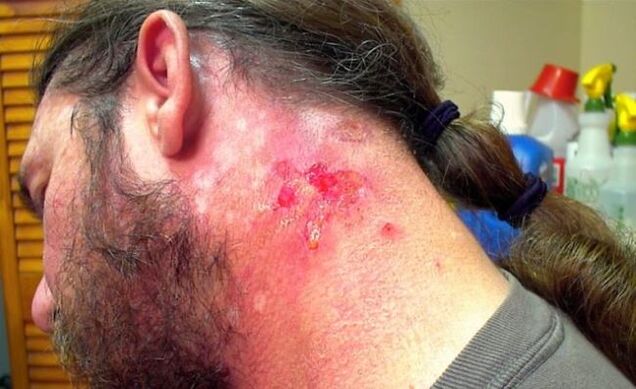Subcutaneous parasites that live in the thickness of human skin damage it, causing inflammation. They can infiltrate other organs from the main place of "deployment" and provoke serious illnesses. Most subcutaneous intestinal worms are found in southern countries and can be contracted by an ordinary person during a vacation or business trip.
The danger of subcutaneous helminthic invasion is that it is asymptomatic during the incubation period, which can take years. This later interferes with the treatment and reduces its effectiveness.

What are subcutaneous parasites?
Helmet patterns affect not only a person’s internal organs but also their skin. Once in their thickness, they damage the epidermis, feed on its cells and empty it. The waste products of subcutaneous worms cause poisoning because they contain toxic substances. And the longer the worms are under a person’s skin, the more pronounced the symptoms of the invasion.
Subcutaneous worms cause a number of diseases because they affect the immune and lymphatic systems of the human body. For example, parasites can provoke the development of elephantism. It interferes with the circulation of lymph in the body. This leads to an increase in the volume of the limbs and distortion. In the last stage, the affected organ is covered with ulcers, necrosis develops.

Subcutaneous human helminths include:
- Nematodes of the genus Dirofilaria. Causes dirofilariasis. The body is infected by biting blood-sucking insects: lice, fleas, ticks, which are larval carriers from one host to another. An adult dirofilaria can reach a length of 30 cm. The reproductive process takes place in the thickness of the skin and then the female places microfilariae in the bloodstream.
- Filariae. Causes philariasis. These are parasitic tapeworms. An adult can reach half a meter, while the body diameter does not exceed 0. 3 mm. Carriers of filariasis are blood-sucking insects that transmit the larvae of the parasite from one host to another.
- Bullworm larvae. A person provokes the development of cysticercosis. Infection occurs through the intestines, where the parasite's eggs penetrate along with water, food, and dirt. After that, their skin dissolves under the influence of gastric juice - the larvae come out. They then pass through the whole body along with the bloodstream.
- Blood from the genus Schistosoma. It's called schistosomiasis. An adult can reach a length of 2 cm. Reproduction occurs by the penetration of larvae into the body - along with the water of the cercariae.
Main manifestations and treatment
If a person has parasites under their skin, this is primarily reflected in their condition: flaccidity, discoloration, scarring, and microcracks appear. This is due to the fact that the "guests" damage the skin, nourish its cells, and poison the waste products.

In humans, subcutaneous parasites cause symptoms of helminthic invasion:
- Allergic rashes;
- Cough;
- Decreased immunity;
- Itchy;
- Exfoliation;
- Appetite problems;
- Pain in joints and muscles;
- Sleep disorders;
- Irritability;
- Apathy.
The skin parasites of a sick person cause dysfunction of the whole body: anemia, dysbacteriosis, etc.
The treatment of the parasitic disease is selected individually. The choice of method is influenced by the degree of damage to the body, the symptoms and the type of pathogen. In some cases, in addition to medication, surgery may be needed to remove the subcutaneous worm, or even the entire organ involved.
Antihistamines and vasoconstrictors are used in combination with anthelmintics. If the inflammation started due to worms living under the skin, antibiotic therapy is needed.
Do not try to get rid of intestinal worms living under the skin alone with the help of traditional medicine - as practice shows, they are ineffective and can harm human health.
Symptoms of filariasis
The subcutaneous worms that cause the disease - filariae - appear in the human body after the bite of a blood-sucking infected insect. Most cases are registered in tropical and subtropical countries.
These subcutaneous worms in humans are able to live in the human body and do not manifest for a long time: the incubation period of the disease can last up to 7 years. This makes diagnosis difficult.

The symptoms and manifestations of the invasion gradually appear as the parasite grows under human skin and has an effect on the surrounding tissues. The most common manifestations of filariasis are:
- Hives;
- Itchy;
- warts;
- eczema;
- Small hard lumps under the skin.
As the disease gets worse, fever, general weakness, headache and drowsiness may occur.
Treatment of filariasis should be performed in a hospital setting. Antiparasitic agents are used for drug deworming. The effectiveness of the therapy is followed by a blood test. In cases where this does not help, the sick person undergoes surgery to restore lymph outflow from the affected organ.
Cysticercosis and schistosomiasis
Tapeworm larvae cause cysticercosis. This type of helminth is characterized by survival: it is sufficient for a parasite to enter the human body and develop rapidly into an adult, which then begins to multiply.
This feature makes it difficult to treat the disease - if the head remains after the worm is surgically removed, the parasite will grow again. Although the adult tapeworm is found in the human gut, its larvae spread throughout the body through the bloodstream, even under the skin. After that, they can stay there for a long time - 5-30 years.
If the worms are wrapped under the skin or in muscle tissue in cysticercosis, the disease is asymptomatic for one person. However, the location of the parasite may be determined by tumor-like tumors rising above the skin. By touching the tuber, it can be seen that it is hollow inside. The skin on the shoulders, the upper half of the chest, and the palms usually become a favorite spot for tapeworm larvae.
In the case of subcutaneous cysticercosis, the drug is not administered, the patient should be under medical supervision. This is due to the fact that when the parasite dies after using antiparasitic agents, the toxins begin to enter the body. These, in turn, can cause a severe allergic reaction.
The larvae of schistosomes, cercariae, cause schistosomiasis in humans. The infection occurs through water. The first symptoms of subcutaneous worms appear 10 to 15 minutes after invasion. This is due to the fact that subcutaneous worms secrete large amounts of their own secretory fluid, which triggers a toxic-allergic reaction in humans.
First manifestations:
- intense itching;
- Hives;
- Rash.
Then there is a break after which (1-2 months later) the acute stage of schistosomiasis begins, suggesting neglect of the disease:
- Fever;
- Nocturnal hyperhidrosis;
- Hives;
- Dry cough;
- Changes in blood quality composition.
Currently, the treatment of schistosomiasis is limited to the use of 2 anthelmintic drugs. Steroids, antihistamines and anti-inflammatory drugs are also used in the acute stage of the disease.
Dirofilaria and Morgellon virus
These two diseases have similar symptoms, with some differences. In dirofilariasis, a sick person finds a small tuber on their body under the skin that moves when touched. This indicates that a subcutaneous worm has been wounded in the body. The same manifestation of invasion is observed for Morgellon virus.

The essential difference between the two parasites is that dirofilaria does not bother its host: the bubble under the skin does not cause discomfort, it can appear and disappear at times. Worms parasitize the arms, legs, near the eyes, nose, chest, and genitals in men. If dirofilaria is under the skin of a person for a long time, the toxins cause the body temperature to rise and weakness to be felt.
With the Morgellon virus, severe itching is felt on the skin of the helminthic invasion. Bleeding wounds and eczema will soon occur without medical help. This multiplies the risk of the body becoming infected with other diseases.
The best treatment for the parasite is surgical removal.






































